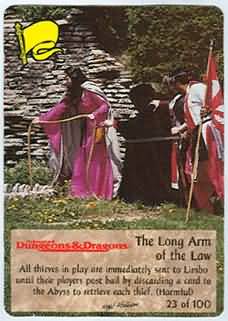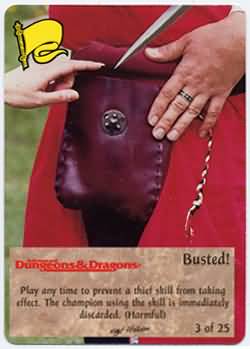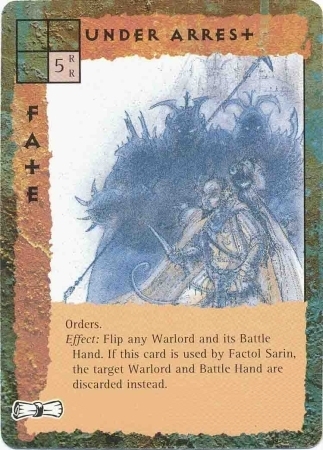Law enforcement in the AD&D® game urban setting
by Dan Howard


| The DM's role | Catching the criminal | Awaiting trial | The trial | Pronouncing judgment |
| 1st Edition AD&D | - | Dragon magazine | - | Dragon #136 |
DRAGON® issue #155 printed many <115>
thief-oriented articles which dealt with
that class?s functions in urban settings. In
several of these articles, the focus was on
the operation of a thieves? guild and the
power that it wields in the average campaign
city. Unfortunately, next to nothing
has been written about this guilds nemesis
and counterbalance: the law.
With the advent of the law-enforcement
material presented herein, the scales of
power will finally be reset. With this in
mind, DMs should advise their players to
remember one thing: "If you want to
dance, you have to pay the piper."
The DM's role
First of all, the DM is required to do a
small amount of preparation. Due to the
varying types of governments, not every
nation in a given campaign world will have
the same laws or use the same methods to
enforce their laws as its kindred nations.
For this reason, the DM must determine
the general alignment slant of each of the
countries in his world.
To determine the alignment of a nation,
the DM must examine its history, the general
alignment of its people, its political
stability, and its wealth. Detailed below are
notes on how these factors relate to the
four elements of law, chaos, good, and
evil.
Law: A lawful society is characterized as
having a history of steady advancement,
obedient and relatively satisfied citizens, a
competent ruler or government, and a
stable economy.
Chaos: A chaotic nation is characterized
as having a turbulent or bloody history,
decadent or self-serving people, an incompetent
or indifferent ruler, a frequently
changing head of state, and a depressed or
fluctuating economy.
Good: A good-aligned society is characterized
as having a history of friendly
cooperation in all governmental aspects,
honest and fair people, and a benign and
conscientious ruler.
Evil: An evil-oriented nation is characterized
as having a history of aggression,
exploitive and brutal citizens who prey on
the weaker members of society, and a
strong and domineering leader.
Upon determining the general alignment
that best fits a country, the DM should
make a permanent note of it. If the DM
deems it necessary, he may start fleshing
out the law procedures of the country in
question at this point, using the guidelines
presented in the rest of this article.
Catching the criminal
The procedure for capturing a lawbreaker
varies only slightly from city to
city. These differences are most noticeable
in the varying procedures and discipline of
the law enforcers.
In most campaign cities, the law enforcers
are a hierarchy of government soldiers,
often called the "watch" (derived
from the Middle English term, wacchen,
meaning to stay awake to keep guard).
Each watchman is hired, paid, equipped,
and trained by the city. These soldiers
regularly patrol the city and man the city?s
watch posts, which are used to house both
prisoners and the watchmen. The following
is an example of a watch patrol:
Patrol leader (1): AC 4; MV 9?; Swordsman;
hp 13;
#AT 1; Dmg by weapon type; AL LN; chain
mail, shield, long sword.
Patrol magic-user (1): AC 10; MV 12?;
MU 2; hp 5; #AT 1; Dmg by weapon type;
AL LG; dagger; spells: charm person,
sleep.
Patrol watchmen (6): AC 5; MV 9?; F1;
hp 8, 7 (x 2), 6, 4 (x 2); #AT 1; Dmg by
weapon type; AL LG-LN; chain mail, halberd
or long sword, dagger, manacles.

Manacles are medieval versions of manacles,
made out of iron. They are usually
locked on the wrists of all criminal suspects.
In most campaigns, manacles reduce
the victim?s dexterity by 4, and all attackers
gain a +2 bonus to hit the victim. At
the DM?s option, manacles can be broken
by a successful bend bars/lift gates roll
(one chance only).
The procedure of the watch can be
reduced to a simple, four-step list:
1. A watch patrol is sent to the scene of
a reported crime or discovers the crime
while patrolling;
2. The patrol restores order;
3. The suspects are arrested and manacled;
and,

4. The suspects are marched to a nearby
watch post and processed.
In step one, the watch is alerted to a
disturbance in the city. The watch can be
called in several ways: the cry of a concerned
citizen, the sight of a wrongful act,
a special gong being rung, etc. A watch
patrol is then sent from the nearest watch
post to investigate, or hurries to the scene
if already on patrol.
In step two, the patrol leader uses his
discretion to determine the best course of
action. This could be waiting for reinforcements,
entering the crime scene, or any
number of other possibilities. If the patrol
enters the crime scene, order will be
restored by either pummeling (if the opponents
are unarmed) or fighting with weapons
(if the opponents are armed). The
patrol continues fighting until the opponents
surrender, the opponents are killed,
or the patrol withdraws (to return with
reinforcements later).
In step three, the patrol manacles all
suspects and prepares to march them to
the nearest watch post. Each suspect is
surrounded on all sides to prevent any
escape.
In step four, the patrol marches the
suspects to the watch post. Once there,
each suspect is identified and the charges
are drafted. Following this processing, the
suspect is marched (under guard) to the
city?s main prison and kept in a large,
common holding cell to await trial.
This procedure is, of course, only a
model. Every city is unique, hence every
city has its own methods for apprehending
lawbreakers. These methods are usually
determined by the alignment slant of the
country, but some methods of enforcement
may be determined by the ruler of
the city. The DM should evaluate the influence
of the city?s ruler, based on his alignment,
then determine the city?s alignment
standing and consider its law-chaos aspect,
which will affect legal procedures as noted
below.
Law: In the average lawful society, the
city is strict in hunting down criminals. It
also has a watch that is well equipped and
finely disciplined. The hierarchy of the
watch officials is clearly defined and
adhered to. Finally, the city has written
procedures regarding the duties, the
patrols, and most other areas of concern
of the watch.
Chaos: In a chaotic city, methods of law
enforcement are more vague and disorganized.
Many criminals are freed at the
time of their arrests or before their trials
(if they know someone in the watch hierarchy).
Additionally, the watch officers
may be lazy or incompetent, often wasting
time and resources. In some cases, it is
doubtful that the watch exists at all;
instead the city relies on vigilante justice
to punish criminals, which may prove as
effective a deterrent as a watch.
Awaiting trial
As noted earlier, the newly captured
suspect is placed in a holding cell with
other suspects awaiting trial. The time the
suspect waits depends on the severity of
the crime. For minor crimes, the waiting
period is 1-3 hours, and the suspect simply
waits. For major crimes, the waiting period
is 1-6 days. These time periods are, of
course, ideal; delays can and do occur.
Suspects awaiting trial for major crimes
have two options. First, the suspect can
hire a barrister (lawyer) to defend him in
court. The suspect can either bribe the
cell guard to summon a barrister or have
one of his friends hire one for him. Since
the suspect is not allowed to have visitors
with the exception of a barrister or city
official, the latter option should be
arranged in advance. If the suspect
belongs to a guild, the guild may hire a
barrister for him.
Second, the suspect can request a meeting
with a city official. The official can be
anyone up to the Lord Mayor or down to a
lowly watchman. However, the granting of
the meeting is left to the official who is
summoned. This meeting (if granted) is
sometimes used to bribe the official,
although its official purpose is to allow
confessions, discuss the charges, and clear
up any other pretrial necessities. In all
cases, after waiting the allotted time,
THE PRISONER is moved under guard to the courtroom for his trial.
Table 1
Modifiers for Court Decisions
| Situation | Modifier |
| Case endangers judge's job if defendant loses | +10* |
| Has higher-paid barrister | +6 |
| Has wealth and influence | +4 |
| Has more witnesses than opposition | +3 |
| Has lower-paid barrister | +3 |
| Has physical evidence | +2 |
| Has no barrister | -2 |
| Has no witnesses | -2 |
Table 2
Sentences for Felonies
| Crime | Typical Sentence | Typical Fine1 |
| Assassination | Public execution | Forfeit assets |
| Murder | Death | Forfeit assets |
| Kidnapping | Death | Forfeit assets |
| Assault2 | Life slavery3 | Forfeit assets |
| Theft4 | Life slavery3 | Forfeit 50% assets |
| Extortion | Beating | Forfeit 10% assets |
| Debt5 | Indentured servitude6 | -- |
| Smuggling | 90 days in jail | 50-300 gp |
| Fencing stolen goods | 30 days in jail | 50-100 gp |
| Forgery | 30 days in jail | 20-80 gp |
Table 3
Sentences for Petty Crimes
| Crime | Typical sentence | Fine1 |
| Evasion of justice | 30 days in jail | Any reward offered |
| Insolence2 | Flogging3 | Any reward offered |
| Petty theft4 | 20 days in jail | Any reward offered |
| Brawling5 | 1-12 days in jail | Any reward offered |
The trial
In most campaign cities, both the criminal
and his accuser are allowed to hire a
barrister to represent them in the courtroom.
Barristers in the AD&D® game,
however, function differently from the
attorneys-at-law of the modern age. In
order to explain how a barrister wins a
case, certain aspects of the profession
must be assumed and understood.
To begin with, every major city sports a
barristers? guild. Since barristers are taken
from the middle class, the guild retains
more city-wide influence than, say, the
lower-class farmers? guild. With this influence,
the guild often gets laws passed that
establish it as the only source of public
defenders. When ineptitude is a serious
problem in a barristers? guild, the guild
usually bribes some of the city?s judges to
favor its members and buys exclusive
access to the written laws for its members.
In return, the members surrender roughly
half their fees to the guild. Since the average
man who defends himself thus does
not know what the laws are, he almost
always loses the case to the professional
barrister. In this way, a corrupt barrister
regularly earns his fee of 100-800 gp by
defending wealthy clients.
At the time of the trial, the criminal's
barrister (if he has one) arrives at the
holding cell with his evidence and witnesses.
From here, the prisoner is escorted
under guard to the courtroom, where a
judge presides over the case and renders a
verdict. The trial processes described
below are basically neutral on a good-evil
scale. Logical adjustments should be made
for cities leaning toward either good or
evil. For example: One is innocent until
proven guilty in good cities; the opposite is
true in evil cities. Further differences
based on alignment are given after the
procedural section.
For a petty crime, the criminal is tried in
petty court. Petty courts have a heavy
caseload; consequently, they try cases in a
rapid-fire manner whenever possible. The
criminal is led into the courtroom, and the
charges are read. Next, the criminal is
given a chance to justify his actions. If he
cannot, he is usually pronounced guilty
and sentenced accordingly.
For a felony crime, the criminal is tried
in a felony court. Here, the criminal is
brought in and the charges against him
are read. The prosecutor, usually called
the Mayor?s Counsel, presents the case
against the suspect. Next, the suspect or
his barrister presents the case for the
defense. After each side has been heard,
the judge determines the verdict.
To determine the verdict in a felony
case, the DM should choose the winning
side if the verdict is obvious. If it is not,
the following system can be used (adapted
from the LANKHMAR: City of Adventure
supplement, page 78). If the verdict is
questionable, roll 2d6 for each side and
add the modifiers shown on Table 1. Modifiers
are cumulative in cases in which
more than one apply. The side with the
highest number wins. In the event of a tie,
the government wins. If the suspect is
found innocent, he is free to leave. If he is
found guilty, he is sentenced by the judge.
To determine the sentence or fine, the
DM should consult Table 2 and Table 3.
The
sentence must be served immediately, but
the fine can be paid at any time within the
next month. The criminal is removed from
the court and taken to a prisoner?s cell
block. Later, his family, is notified and the
fine is collected from them. If the prisoner
has no family, the fine is taken out of his
belongings. If he cannot afford the fine, he
may be charged with debt.
When determining how a city's general
alignment affects the trial, the DM should
only consider the good-evil component of
the city, as per the appropriate paragraph:
Good: In the average good society, the
judge is intent on finding the truth and
administering justice. The court may hire
barristers for the poor or allow every
defendant access to the city?s archives.
Also, the government may pass civil-rights
legislation that ensures a fair trial. Corruption
and brutality during arrest are investigated
by a special government section.
Evil: In an evil society, the trial process
attempts to forcefully suppress the criminal
element. The government may outlaw
barristers, leaving the defendant to defend
himself. Punishment may be brutal. The
ruler may destroy his enemies through the
law, but all allies (such as his judges, vassals,
etc.) are above prosecution.
Pronouncing judgment
One final subject must be covered: pronouncing
judgment on the defendant. The
sentence of a guilty PC criminal must be
short yet effective. Table 2 and Table
3 reflect
this in their design, as most of the sentences
can be carried out within three
months. By using this system, the rest of
the players have to play for less than three
game months before they can be reunited
with their companion.
In the meantime, while the criminal
waits in prison, the party may embark on
a few adventures, gaining some treasure
and magic. The deprivation of this money
and magic is painful for the criminal, but
it does not alienate him from the campaign.
The jailed PC?s player may run
another character during this time.
For those PC criminals sentenced to
death or life slavery, the DM should allow
a chance or two for escape. The city may
offer to suspend the sentence if the criminal
performs a community service. Alternately,
cell doors and shackles can be
weak from rust and rot. In fact, the criminal
?s companions may solve the DM?s problem
by planning to rescue their comrade.
Thus, with the law as a more potent
threat, the PC criminal element is held in
check. Even in the AD&D game, evil PCs
cannot run the world.
AUGUST 1988